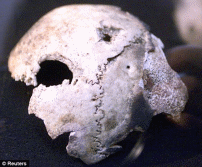Any information about Hitler generates a lot of interest. Money is also made in keeping afloat conspiracy theories related to him. An especially common discussion is that Hitler did not kill himself during Soviet’s final offensive on Berlin. According to an article by Justice for Germans (2013), pessimists believe that he escaped either to Argentina or a safer hideout in the South Pole.
Nonetheless, many people see this propaganda as a plot to depict Hitler as a coward and a traitor. From the onset of the war, Hitler proved to be a trustworthy leader. Consequently, he was loved, respected and obeyed by the people he led. His charisma and ability to lead from the front were some of the factors that sustained the Second World War.
Therefore, the outcome of this war was expected to determine Hitler’s fate. Those who believe that Hitler outsmarted the allies are set to be disappointed. There is compelling evidence that he died in 1945. This essay uses evidence from forensic anthropology to describe Hitler’s death.
Hitler chose to kill himself rather than fall from an enemy’s bullet. This happened when it dawned on him that he had lost the war to the Allies. In fact, it is believed that the Soviet army was just five hundred meters from his hideout when he committed suicide (Justice for Germans, 2013). Sadly, his wife, Eva Braun, died in the same incident. Their remains we later found on ruins in Berlin by the Soviet troops (Jamieson, 2009).
Debate on Hitler’s death was stirred by contradicting information given by the Soviet leadership. In some instances, Soviet leaders seemed to indicate that Hitler did not survive their raid. However, later utterance would prove otherwise. For instance, an announcement made by the Soviet army’s spokesman in June 1945 confirmed that Hitler had killed himself. Later pronouncements, nonetheless, contradicted this announcement.
Stalin’s statement at the Potsdam conference was a typical example of these inconsistent statements. In this conference, he told the Western leaders that Hitler had fled to South America or Spain (Justice for Germans, 2013). Other interesting stories about the Nazi leader’s death have emerged after this utterance.
There is a common agreement among historians that Hitler died. Ample forensic evidence and anthropology analysis support this claim. For instance, experts used dental evidence to identify Hitler after a postmortem was conducted on his body. In this postmortem, his dentist identified positively a cut on the bridge that separated two of his teeth (Jamieson, 2009). Due to his earlier dental problems, his teeth and the jaw bones were familiar with his dentist.
In 2000, Hitler’s skull was displayed in an archive in Moscow (Mail Foreign Service, 2009). This gave people a chance to observe and analyze the bullet hole in it. Majority of scientists and historians have agreed that this is indeed Hitler’s skull. Testimonies from people who witnessed his death also add weight to the overwhelming forensic evidence (Mail Foreign Service, 2009). These discoveries put to rest all doubts that Hitler did not die in 1945.

Figure 1. An X-ray of Hitler’s skull. Part of the bridge between his 5th and 6th tooth on the upper jaw that was cut in an earlier operation is clearly visible.
According to Mail Foreign Service (2009), Hitler may not have committed suicide. Results from DNA analysis done on a piece of the skull thought to belong to Hitler disclosed that it matched a woman (Mail Foreign Service, 2009). This analysis was done in the US. The bones also seemed to be weaker than men’s bones.
Citing Nick Bellantoni, an archeologist from the University of Connecticut, Mail Foreign Service (2009) reiterates that the skull plates, when brought together, appeared to correspond to a person below the age of 40. In April 1945, the Nazi leader was 56. This is an indication that the preserved skull may not have belonged to him. Since Eva Braun died at the age of thirty three years, the skull could have been hers.
Marcheti, Boschi, Polacco and Rainio (2005) add that Hitler’s death remains a mystery. Evidence supporting his death is inconclusive since the skull with the bullet hole has never been properly examined (Marcheti et al., 2005). If these analyses are true, claims that Hitler survived the Soviet onslaught on Berlin should be taken seriously.

Fig 2. Hitler’s skull at a Russian archive. The bullet hole is undoubtedly noticeable from this angle.
Theories denying that Hitler was killed in Second World War are popular and extensive. To some historians, claims that Hitler committed suicide were a scheme by the Nazi to portray him as hero. In the US, tests done on a part of the skull purported to be Hitler’s have given unconvincing results.
Nonetheless, there is overwhelming proof that all rumors surrounding Hitler’s death are hoaxes. Dental and other forensic evidences show that the body found by the Soviet army was actually Hitler’s. This was after observing the teeth, jaw bone and the work done on a bridge separating two of his teeth.
References
An X-ray of Hitler’s skull [Photograph]. (1945). Web.
Hitler’s skull at a Russian archive [Photograph]. (n.d.). Web.
Jamieson, A. (2009). Adolf Hitler skull fragment is genuine evidence of suicide, insists Russia. The Telegraph. Web.
Justice for Germans. (2013). Debunking the “Hitler escaped” myths – Forensic evidence trumps rumours, theories and romantic tales.Web.
Mail Foreign Service. (2009). Fresh doubts over Hitler’s death after tests on bullet hole skull reveal it belonged to a woman. Mail Online.Web.
Marchetti, D., Boschi, I, Polacco, M., & Rainio, J. (2005).The death of Adolf Hitler–forensic aspects. Journal of Forensic Sciences, (50(5), 1147-53. Web.